Operations and Project Management: A Detailed Report (Unit 16)
VerifiedAdded on 2022/12/01
|20
|5757
|93
Report
AI Summary
This report provides a comprehensive analysis of operations and project management principles, utilizing Unilever as a primary case study. It begins with a critique of Unilever's implementation of operations management, covering key aspects such as business operations, the application of Six Sigma methodology, and Lean principles. The report then develops a continuous improvement plan, examining its effectiveness through relevant theories, concepts, and models. Furthermore, the report applies the stages of the Product Life Cycle (PLC) to a given project, producing supporting documentation and analyzing project methodologies, tools, and leadership within the PLC. The effectiveness of the PLC is reviewed and critiqued, with a focus on how theoretical frameworks differentiate between large and small-scale projects, leading to valid conclusions and recommendations for improvement. The report integrates various theories and concepts to justify strategies for achieving improved efficiency within the context of operations and project management, offering insights into best practices and potential enhancements.
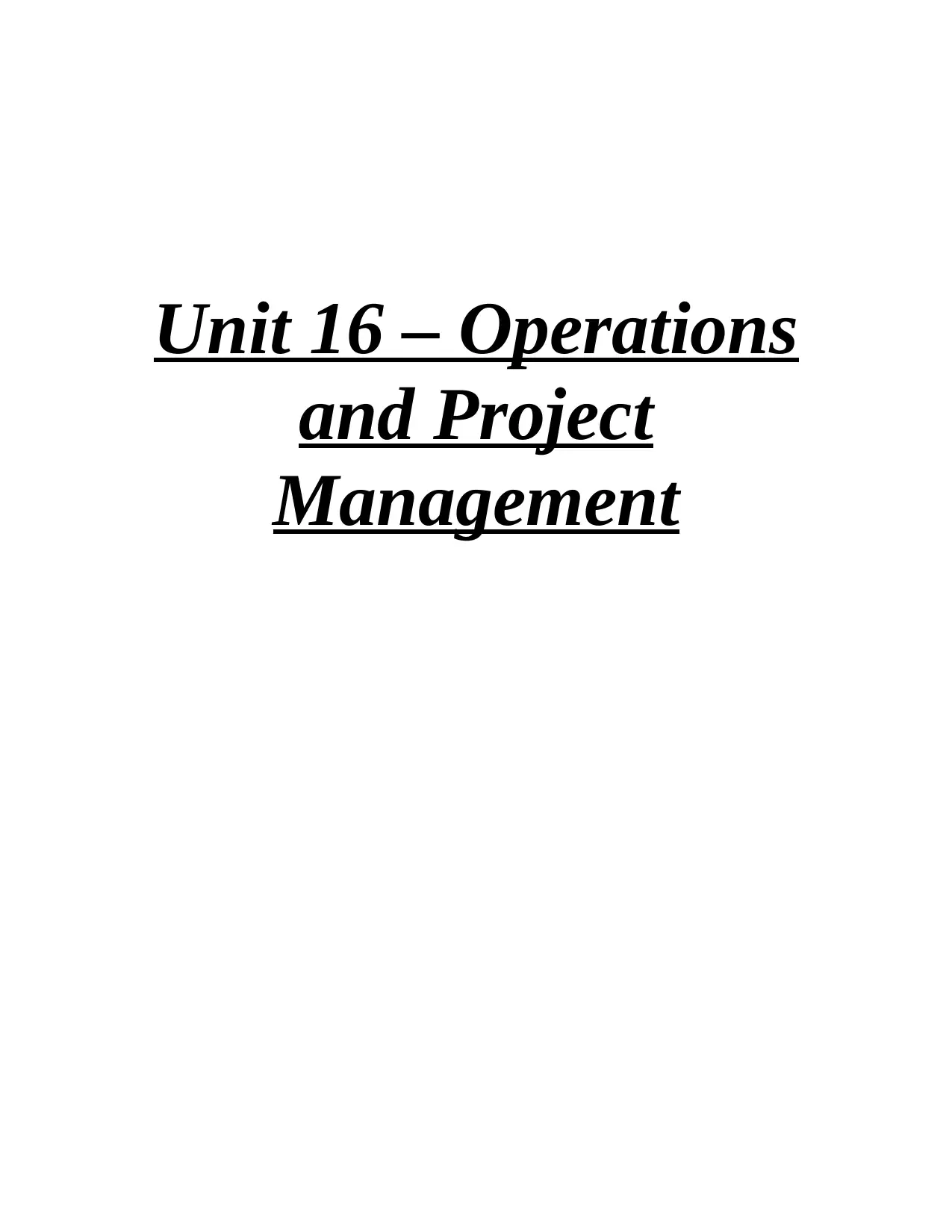
Unit 16 – Operations
and Project
Management
and Project
Management
Paraphrase This Document
Need a fresh take? Get an instant paraphrase of this document with our AI Paraphraser
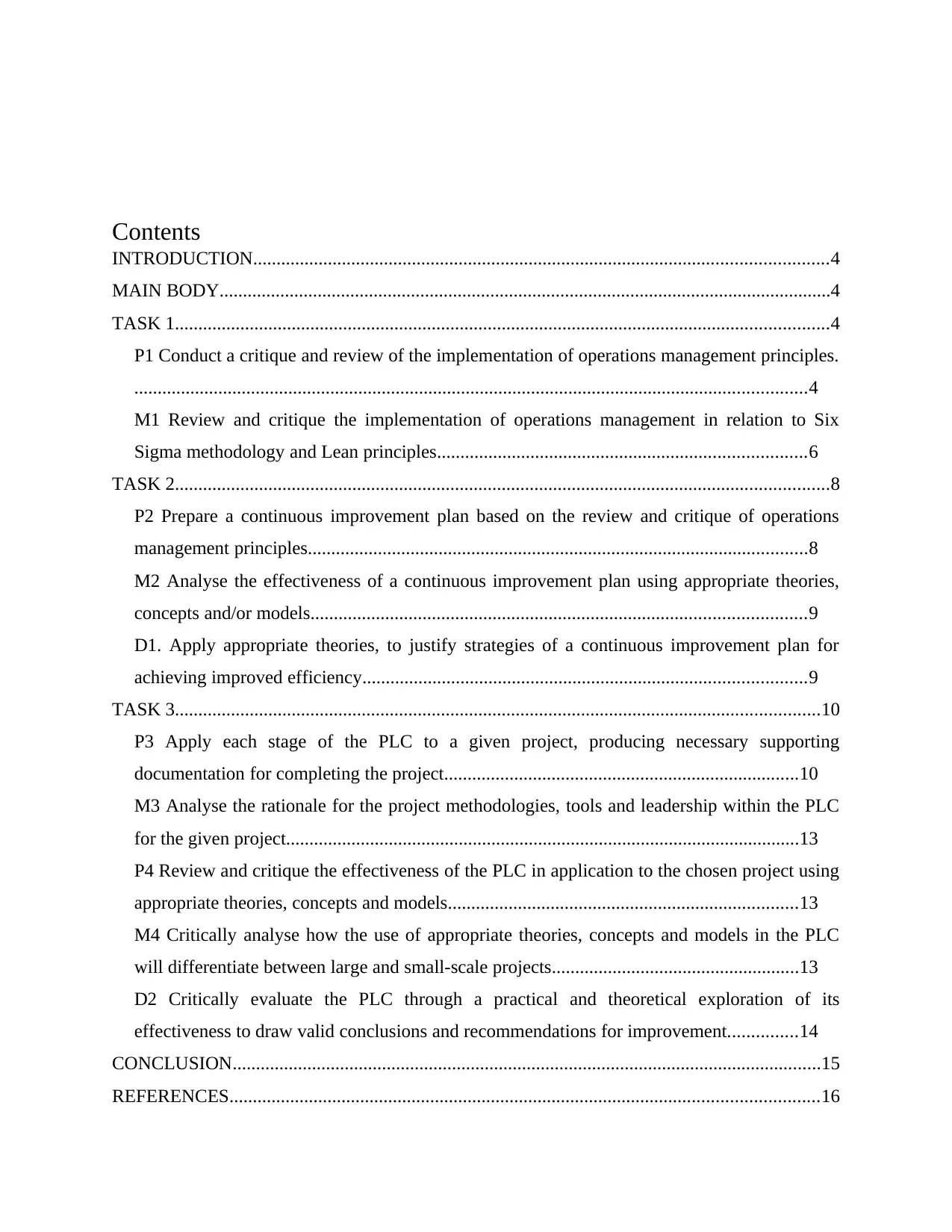
Contents
INTRODUCTION...........................................................................................................................4
MAIN BODY...................................................................................................................................4
TASK 1............................................................................................................................................4
P1 Conduct a critique and review of the implementation of operations management principles.
................................................................................................................................................4
M1 Review and critique the implementation of operations management in relation to Six
Sigma methodology and Lean principles...............................................................................6
TASK 2............................................................................................................................................8
P2 Prepare a continuous improvement plan based on the review and critique of operations
management principles...........................................................................................................8
M2 Analyse the effectiveness of a continuous improvement plan using appropriate theories,
concepts and/or models..........................................................................................................9
D1. Apply appropriate theories, to justify strategies of a continuous improvement plan for
achieving improved efficiency...............................................................................................9
TASK 3..........................................................................................................................................10
P3 Apply each stage of the PLC to a given project, producing necessary supporting
documentation for completing the project............................................................................10
M3 Analyse the rationale for the project methodologies, tools and leadership within the PLC
for the given project..............................................................................................................13
P4 Review and critique the effectiveness of the PLC in application to the chosen project using
appropriate theories, concepts and models...........................................................................13
M4 Critically analyse how the use of appropriate theories, concepts and models in the PLC
will differentiate between large and small-scale projects.....................................................13
D2 Critically evaluate the PLC through a practical and theoretical exploration of its
effectiveness to draw valid conclusions and recommendations for improvement...............14
CONCLUSION..............................................................................................................................15
REFERENCES..............................................................................................................................16
INTRODUCTION...........................................................................................................................4
MAIN BODY...................................................................................................................................4
TASK 1............................................................................................................................................4
P1 Conduct a critique and review of the implementation of operations management principles.
................................................................................................................................................4
M1 Review and critique the implementation of operations management in relation to Six
Sigma methodology and Lean principles...............................................................................6
TASK 2............................................................................................................................................8
P2 Prepare a continuous improvement plan based on the review and critique of operations
management principles...........................................................................................................8
M2 Analyse the effectiveness of a continuous improvement plan using appropriate theories,
concepts and/or models..........................................................................................................9
D1. Apply appropriate theories, to justify strategies of a continuous improvement plan for
achieving improved efficiency...............................................................................................9
TASK 3..........................................................................................................................................10
P3 Apply each stage of the PLC to a given project, producing necessary supporting
documentation for completing the project............................................................................10
M3 Analyse the rationale for the project methodologies, tools and leadership within the PLC
for the given project..............................................................................................................13
P4 Review and critique the effectiveness of the PLC in application to the chosen project using
appropriate theories, concepts and models...........................................................................13
M4 Critically analyse how the use of appropriate theories, concepts and models in the PLC
will differentiate between large and small-scale projects.....................................................13
D2 Critically evaluate the PLC through a practical and theoretical exploration of its
effectiveness to draw valid conclusions and recommendations for improvement...............14
CONCLUSION..............................................................................................................................15
REFERENCES..............................................................................................................................16

Books and Journals...............................................................................................................16
⊘ This is a preview!⊘
Do you want full access?
Subscribe today to unlock all pages.

Trusted by 1+ million students worldwide
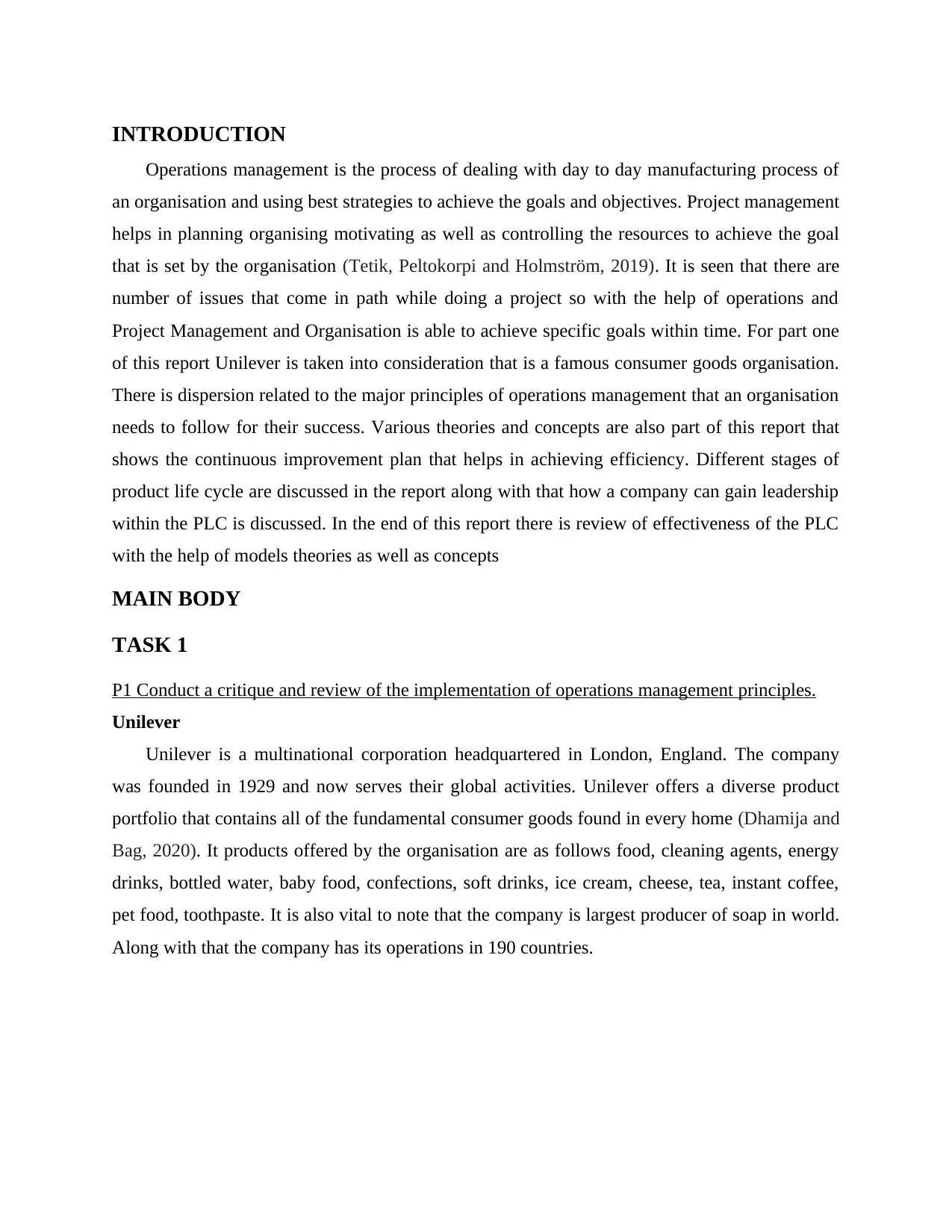
INTRODUCTION
Operations management is the process of dealing with day to day manufacturing process of
an organisation and using best strategies to achieve the goals and objectives. Project management
helps in planning organising motivating as well as controlling the resources to achieve the goal
that is set by the organisation (Tetik, Peltokorpi and Holmström, 2019). It is seen that there are
number of issues that come in path while doing a project so with the help of operations and
Project Management and Organisation is able to achieve specific goals within time. For part one
of this report Unilever is taken into consideration that is a famous consumer goods organisation.
There is dispersion related to the major principles of operations management that an organisation
needs to follow for their success. Various theories and concepts are also part of this report that
shows the continuous improvement plan that helps in achieving efficiency. Different stages of
product life cycle are discussed in the report along with that how a company can gain leadership
within the PLC is discussed. In the end of this report there is review of effectiveness of the PLC
with the help of models theories as well as concepts
MAIN BODY
TASK 1
P1 Conduct a critique and review of the implementation of operations management principles.
Unilever
Unilever is a multinational corporation headquartered in London, England. The company
was founded in 1929 and now serves their global activities. Unilever offers a diverse product
portfolio that contains all of the fundamental consumer goods found in every home (Dhamija and
Bag, 2020). It products offered by the organisation are as follows food, cleaning agents, energy
drinks, bottled water, baby food, confections, soft drinks, ice cream, cheese, tea, instant coffee,
pet food, toothpaste. It is also vital to note that the company is largest producer of soap in world.
Along with that the company has its operations in 190 countries.
Operations management is the process of dealing with day to day manufacturing process of
an organisation and using best strategies to achieve the goals and objectives. Project management
helps in planning organising motivating as well as controlling the resources to achieve the goal
that is set by the organisation (Tetik, Peltokorpi and Holmström, 2019). It is seen that there are
number of issues that come in path while doing a project so with the help of operations and
Project Management and Organisation is able to achieve specific goals within time. For part one
of this report Unilever is taken into consideration that is a famous consumer goods organisation.
There is dispersion related to the major principles of operations management that an organisation
needs to follow for their success. Various theories and concepts are also part of this report that
shows the continuous improvement plan that helps in achieving efficiency. Different stages of
product life cycle are discussed in the report along with that how a company can gain leadership
within the PLC is discussed. In the end of this report there is review of effectiveness of the PLC
with the help of models theories as well as concepts
MAIN BODY
TASK 1
P1 Conduct a critique and review of the implementation of operations management principles.
Unilever
Unilever is a multinational corporation headquartered in London, England. The company
was founded in 1929 and now serves their global activities. Unilever offers a diverse product
portfolio that contains all of the fundamental consumer goods found in every home (Dhamija and
Bag, 2020). It products offered by the organisation are as follows food, cleaning agents, energy
drinks, bottled water, baby food, confections, soft drinks, ice cream, cheese, tea, instant coffee,
pet food, toothpaste. It is also vital to note that the company is largest producer of soap in world.
Along with that the company has its operations in 190 countries.
Paraphrase This Document
Need a fresh take? Get an instant paraphrase of this document with our AI Paraphraser
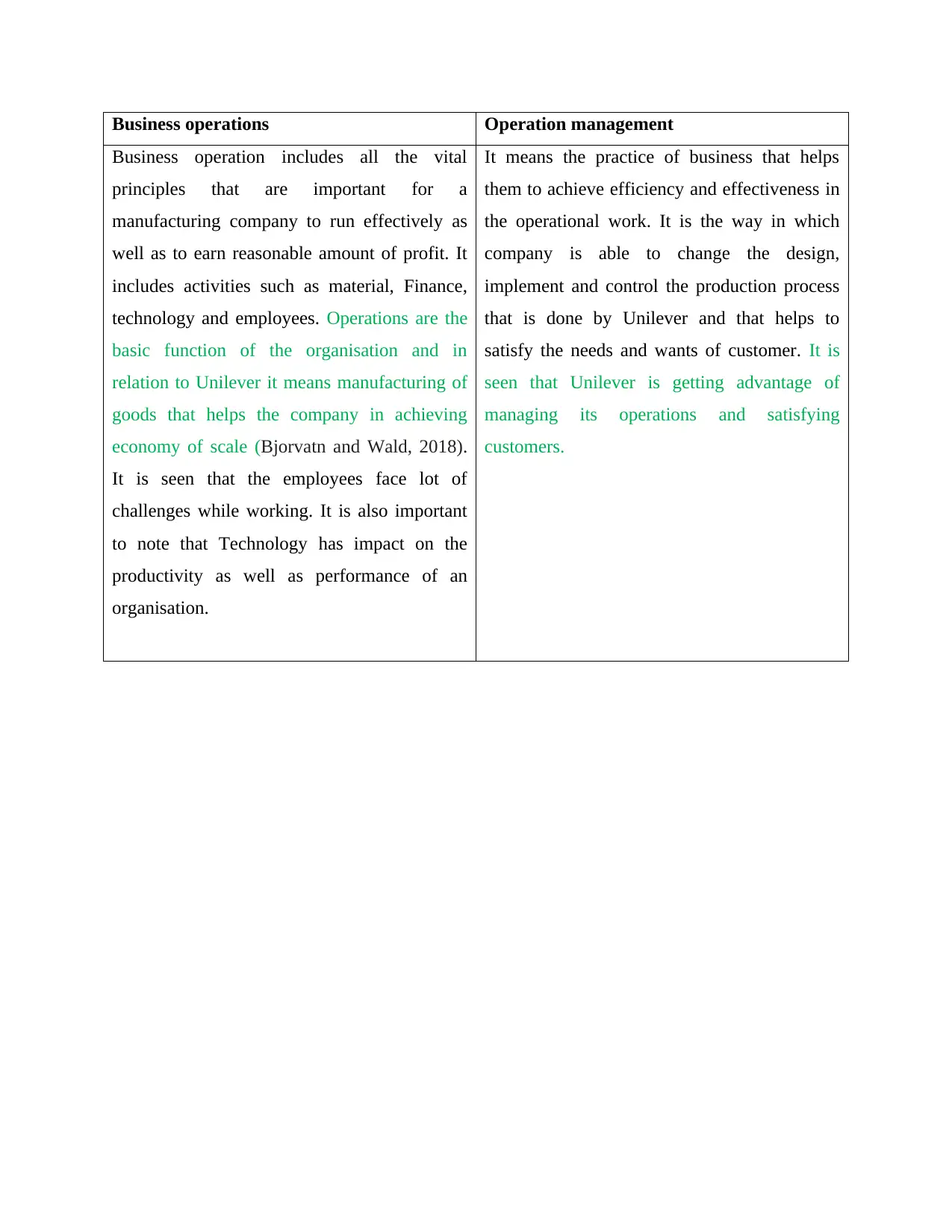
Business operations Operation management
Business operation includes all the vital
principles that are important for a
manufacturing company to run effectively as
well as to earn reasonable amount of profit. It
includes activities such as material, Finance,
technology and employees. Operations are the
basic function of the organisation and in
relation to Unilever it means manufacturing of
goods that helps the company in achieving
economy of scale (Bjorvatn and Wald, 2018).
It is seen that the employees face lot of
challenges while working. It is also important
to note that Technology has impact on the
productivity as well as performance of an
organisation.
It means the practice of business that helps
them to achieve efficiency and effectiveness in
the operational work. It is the way in which
company is able to change the design,
implement and control the production process
that is done by Unilever and that helps to
satisfy the needs and wants of customer. It is
seen that Unilever is getting advantage of
managing its operations and satisfying
customers.
Business operation includes all the vital
principles that are important for a
manufacturing company to run effectively as
well as to earn reasonable amount of profit. It
includes activities such as material, Finance,
technology and employees. Operations are the
basic function of the organisation and in
relation to Unilever it means manufacturing of
goods that helps the company in achieving
economy of scale (Bjorvatn and Wald, 2018).
It is seen that the employees face lot of
challenges while working. It is also important
to note that Technology has impact on the
productivity as well as performance of an
organisation.
It means the practice of business that helps
them to achieve efficiency and effectiveness in
the operational work. It is the way in which
company is able to change the design,
implement and control the production process
that is done by Unilever and that helps to
satisfy the needs and wants of customer. It is
seen that Unilever is getting advantage of
managing its operations and satisfying
customers.
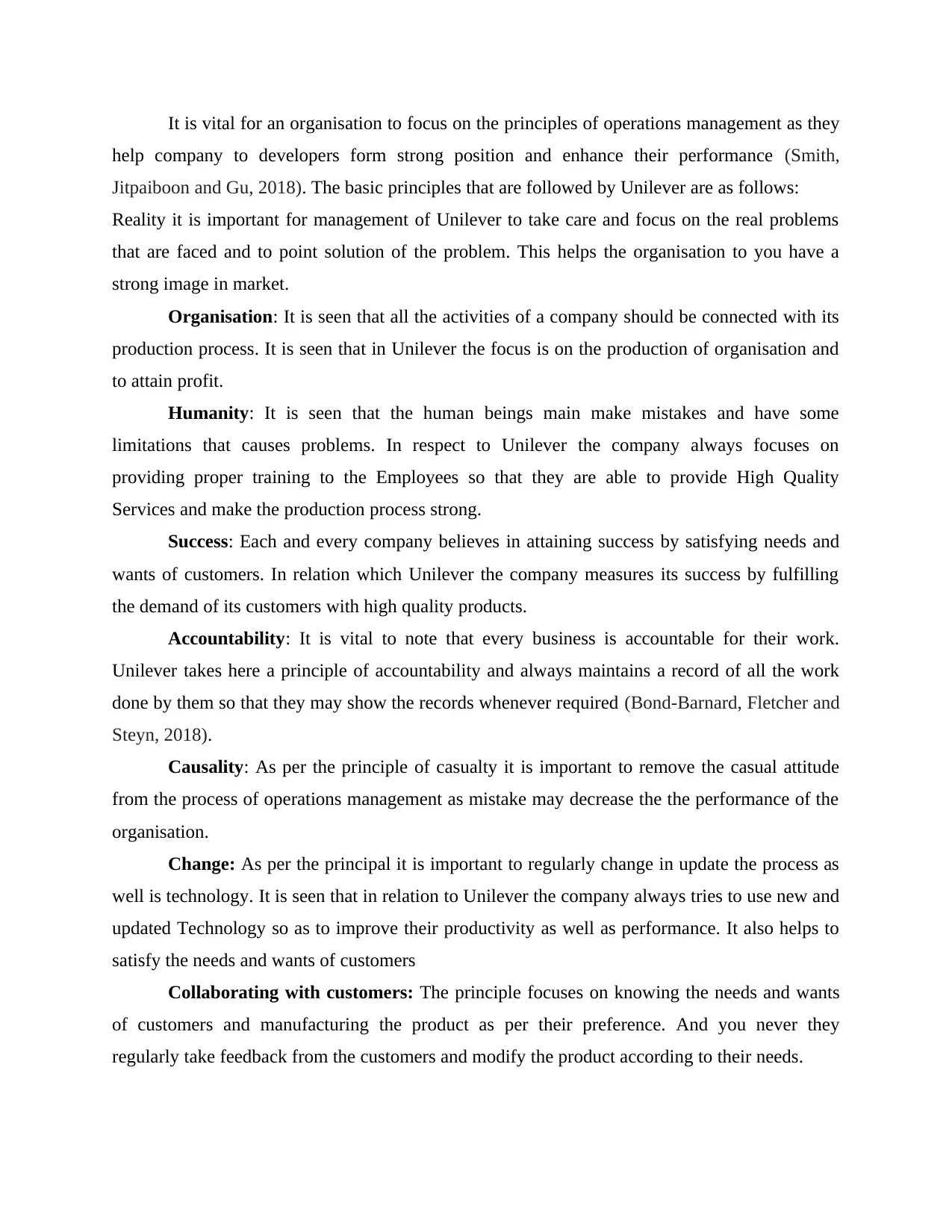
It is vital for an organisation to focus on the principles of operations management as they
help company to developers form strong position and enhance their performance (Smith,
Jitpaiboon and Gu, 2018). The basic principles that are followed by Unilever are as follows:
Reality it is important for management of Unilever to take care and focus on the real problems
that are faced and to point solution of the problem. This helps the organisation to you have a
strong image in market.
Organisation: It is seen that all the activities of a company should be connected with its
production process. It is seen that in Unilever the focus is on the production of organisation and
to attain profit.
Humanity: It is seen that the human beings main make mistakes and have some
limitations that causes problems. In respect to Unilever the company always focuses on
providing proper training to the Employees so that they are able to provide High Quality
Services and make the production process strong.
Success: Each and every company believes in attaining success by satisfying needs and
wants of customers. In relation which Unilever the company measures its success by fulfilling
the demand of its customers with high quality products.
Accountability: It is vital to note that every business is accountable for their work.
Unilever takes here a principle of accountability and always maintains a record of all the work
done by them so that they may show the records whenever required (Bond-Barnard, Fletcher and
Steyn, 2018).
Causality: As per the principle of casualty it is important to remove the casual attitude
from the process of operations management as mistake may decrease the the performance of the
organisation.
Change: As per the principal it is important to regularly change in update the process as
well is technology. It is seen that in relation to Unilever the company always tries to use new and
updated Technology so as to improve their productivity as well as performance. It also helps to
satisfy the needs and wants of customers
Collaborating with customers: The principle focuses on knowing the needs and wants
of customers and manufacturing the product as per their preference. And you never they
regularly take feedback from the customers and modify the product according to their needs.
help company to developers form strong position and enhance their performance (Smith,
Jitpaiboon and Gu, 2018). The basic principles that are followed by Unilever are as follows:
Reality it is important for management of Unilever to take care and focus on the real problems
that are faced and to point solution of the problem. This helps the organisation to you have a
strong image in market.
Organisation: It is seen that all the activities of a company should be connected with its
production process. It is seen that in Unilever the focus is on the production of organisation and
to attain profit.
Humanity: It is seen that the human beings main make mistakes and have some
limitations that causes problems. In respect to Unilever the company always focuses on
providing proper training to the Employees so that they are able to provide High Quality
Services and make the production process strong.
Success: Each and every company believes in attaining success by satisfying needs and
wants of customers. In relation which Unilever the company measures its success by fulfilling
the demand of its customers with high quality products.
Accountability: It is vital to note that every business is accountable for their work.
Unilever takes here a principle of accountability and always maintains a record of all the work
done by them so that they may show the records whenever required (Bond-Barnard, Fletcher and
Steyn, 2018).
Causality: As per the principle of casualty it is important to remove the casual attitude
from the process of operations management as mistake may decrease the the performance of the
organisation.
Change: As per the principal it is important to regularly change in update the process as
well is technology. It is seen that in relation to Unilever the company always tries to use new and
updated Technology so as to improve their productivity as well as performance. It also helps to
satisfy the needs and wants of customers
Collaborating with customers: The principle focuses on knowing the needs and wants
of customers and manufacturing the product as per their preference. And you never they
regularly take feedback from the customers and modify the product according to their needs.
⊘ This is a preview!⊘
Do you want full access?
Subscribe today to unlock all pages.

Trusted by 1+ million students worldwide
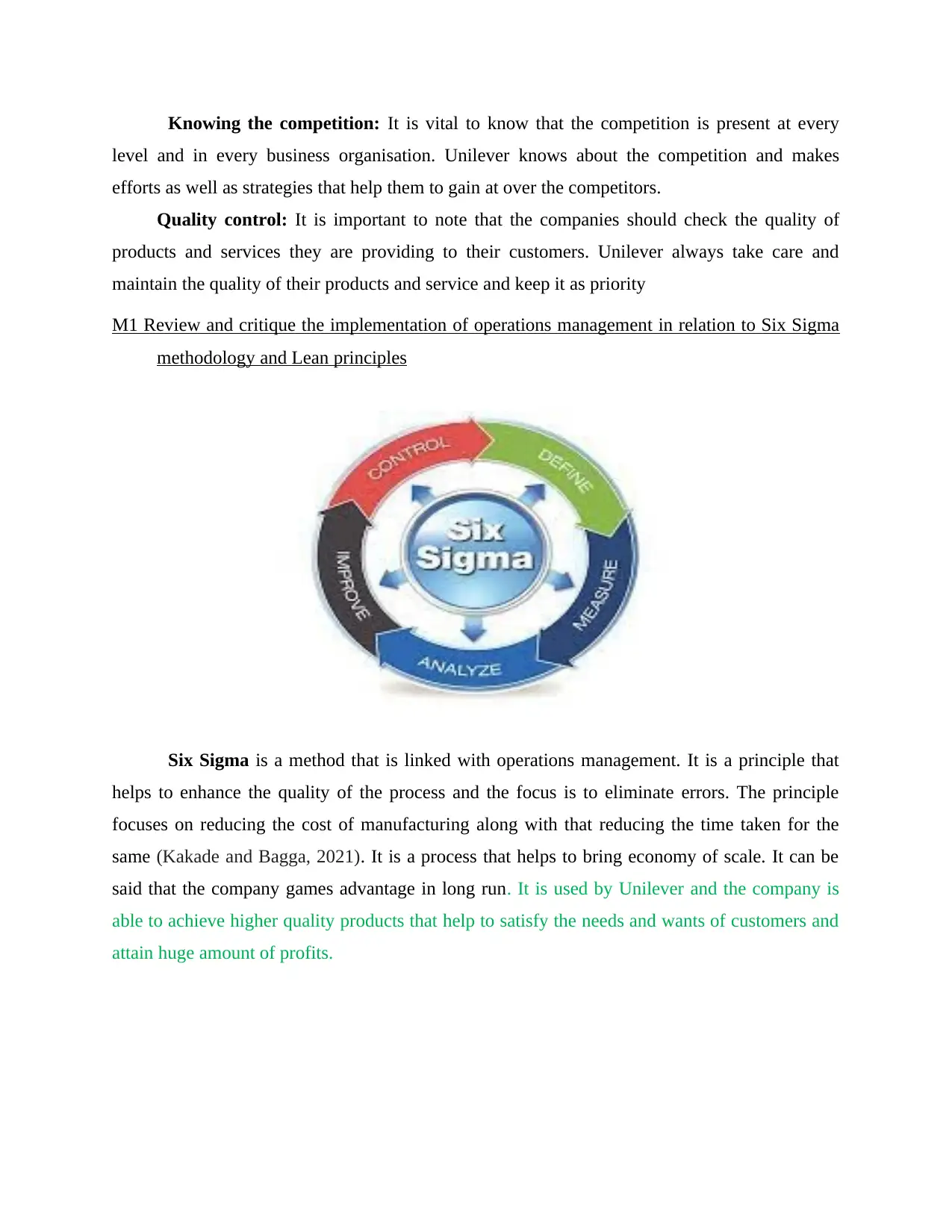
Knowing the competition: It is vital to know that the competition is present at every
level and in every business organisation. Unilever knows about the competition and makes
efforts as well as strategies that help them to gain at over the competitors.
Quality control: It is important to note that the companies should check the quality of
products and services they are providing to their customers. Unilever always take care and
maintain the quality of their products and service and keep it as priority
M1 Review and critique the implementation of operations management in relation to Six Sigma
methodology and Lean principles
Six Sigma is a method that is linked with operations management. It is a principle that
helps to enhance the quality of the process and the focus is to eliminate errors. The principle
focuses on reducing the cost of manufacturing along with that reducing the time taken for the
same (Kakade and Bagga, 2021). It is a process that helps to bring economy of scale. It can be
said that the company games advantage in long run. It is used by Unilever and the company is
able to achieve higher quality products that help to satisfy the needs and wants of customers and
attain huge amount of profits.
level and in every business organisation. Unilever knows about the competition and makes
efforts as well as strategies that help them to gain at over the competitors.
Quality control: It is important to note that the companies should check the quality of
products and services they are providing to their customers. Unilever always take care and
maintain the quality of their products and service and keep it as priority
M1 Review and critique the implementation of operations management in relation to Six Sigma
methodology and Lean principles
Six Sigma is a method that is linked with operations management. It is a principle that
helps to enhance the quality of the process and the focus is to eliminate errors. The principle
focuses on reducing the cost of manufacturing along with that reducing the time taken for the
same (Kakade and Bagga, 2021). It is a process that helps to bring economy of scale. It can be
said that the company games advantage in long run. It is used by Unilever and the company is
able to achieve higher quality products that help to satisfy the needs and wants of customers and
attain huge amount of profits.
Paraphrase This Document
Need a fresh take? Get an instant paraphrase of this document with our AI Paraphraser
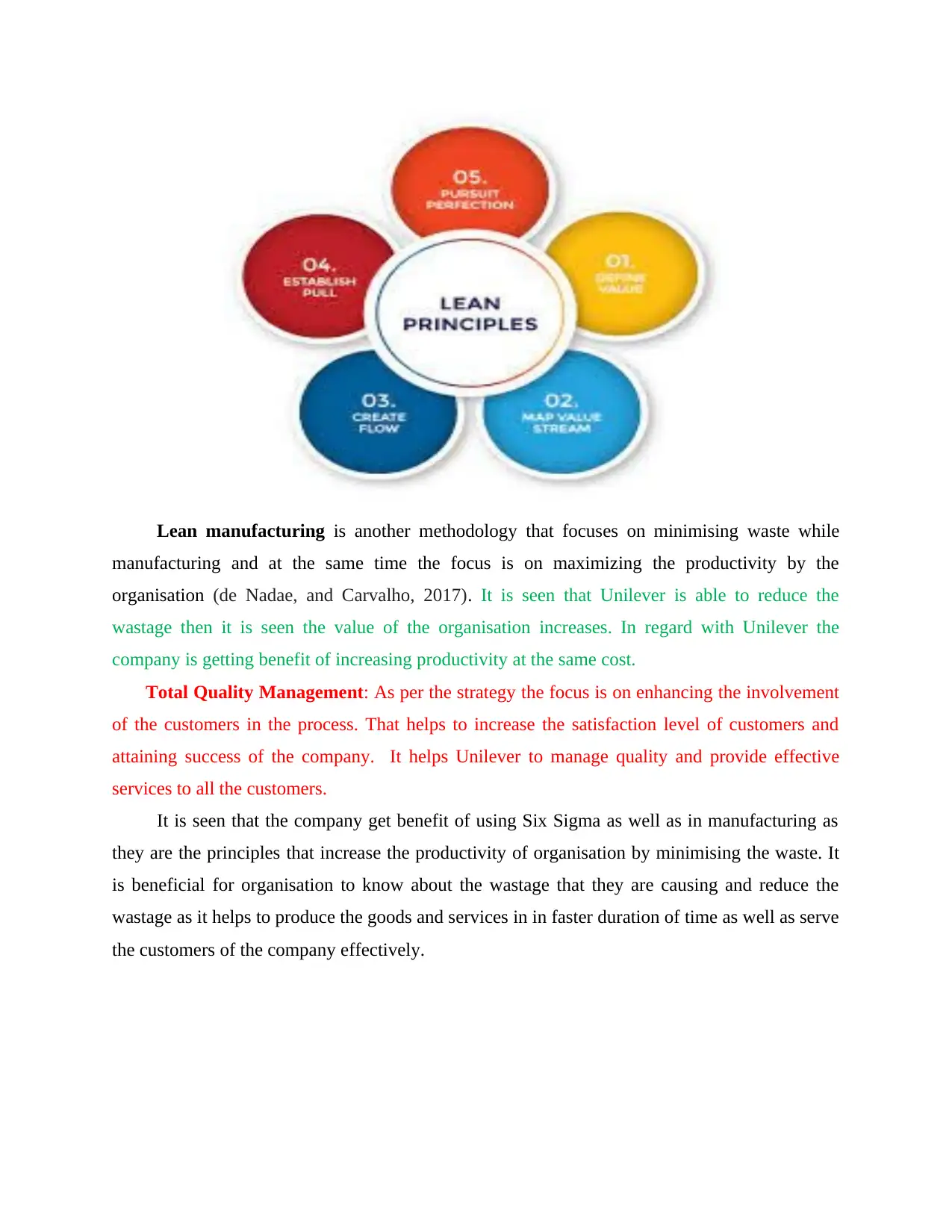
Lean manufacturing is another methodology that focuses on minimising waste while
manufacturing and at the same time the focus is on maximizing the productivity by the
organisation (de Nadae, and Carvalho, 2017). It is seen that Unilever is able to reduce the
wastage then it is seen the value of the organisation increases. In regard with Unilever the
company is getting benefit of increasing productivity at the same cost.
Total Quality Management: As per the strategy the focus is on enhancing the involvement
of the customers in the process. That helps to increase the satisfaction level of customers and
attaining success of the company. It helps Unilever to manage quality and provide effective
services to all the customers.
It is seen that the company get benefit of using Six Sigma as well as in manufacturing as
they are the principles that increase the productivity of organisation by minimising the waste. It
is beneficial for organisation to know about the wastage that they are causing and reduce the
wastage as it helps to produce the goods and services in in faster duration of time as well as serve
the customers of the company effectively.
manufacturing and at the same time the focus is on maximizing the productivity by the
organisation (de Nadae, and Carvalho, 2017). It is seen that Unilever is able to reduce the
wastage then it is seen the value of the organisation increases. In regard with Unilever the
company is getting benefit of increasing productivity at the same cost.
Total Quality Management: As per the strategy the focus is on enhancing the involvement
of the customers in the process. That helps to increase the satisfaction level of customers and
attaining success of the company. It helps Unilever to manage quality and provide effective
services to all the customers.
It is seen that the company get benefit of using Six Sigma as well as in manufacturing as
they are the principles that increase the productivity of organisation by minimising the waste. It
is beneficial for organisation to know about the wastage that they are causing and reduce the
wastage as it helps to produce the goods and services in in faster duration of time as well as serve
the customers of the company effectively.
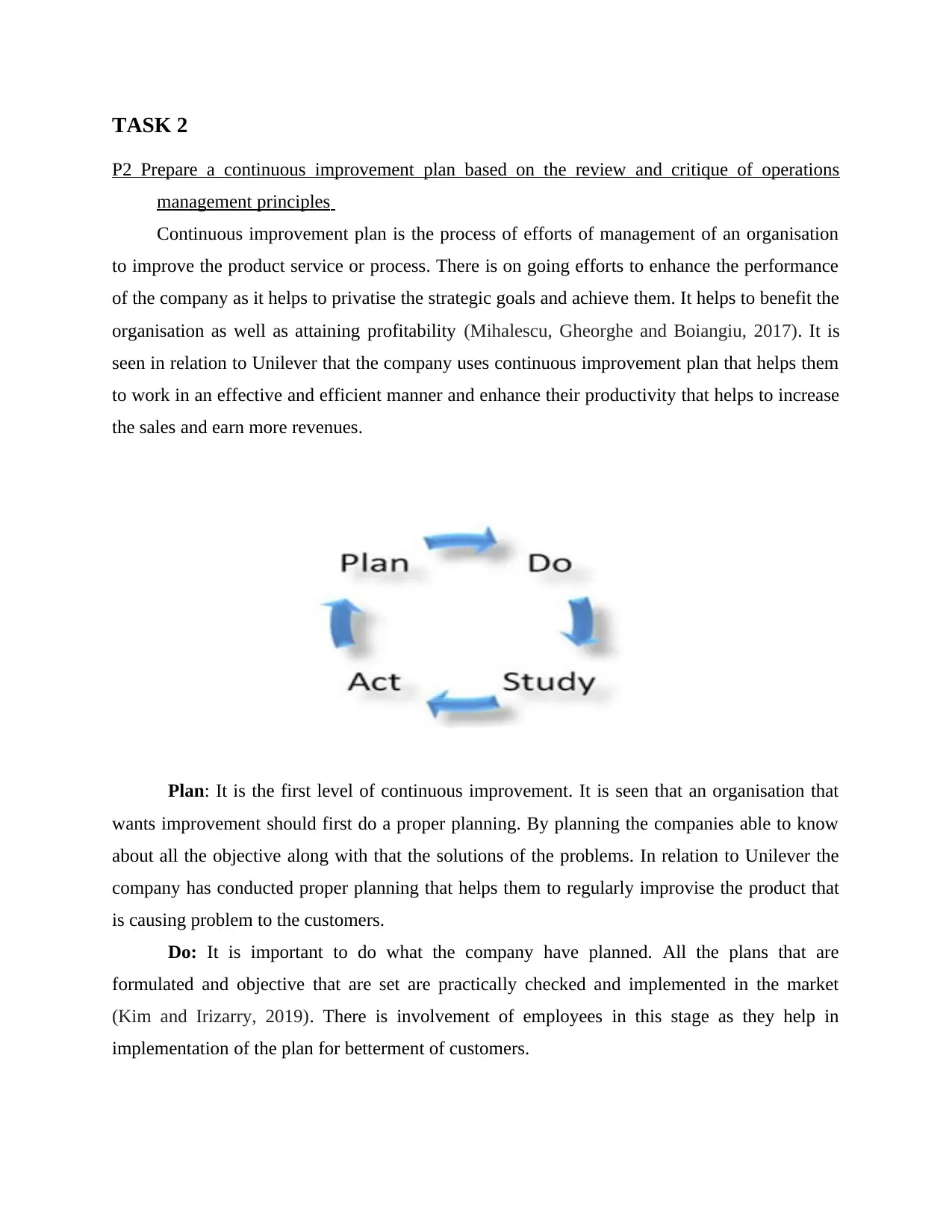
TASK 2
P2 Prepare a continuous improvement plan based on the review and critique of operations
management principles
Continuous improvement plan is the process of efforts of management of an organisation
to improve the product service or process. There is on going efforts to enhance the performance
of the company as it helps to privatise the strategic goals and achieve them. It helps to benefit the
organisation as well as attaining profitability (Mihalescu, Gheorghe and Boiangiu, 2017). It is
seen in relation to Unilever that the company uses continuous improvement plan that helps them
to work in an effective and efficient manner and enhance their productivity that helps to increase
the sales and earn more revenues.
Plan: It is the first level of continuous improvement. It is seen that an organisation that
wants improvement should first do a proper planning. By planning the companies able to know
about all the objective along with that the solutions of the problems. In relation to Unilever the
company has conducted proper planning that helps them to regularly improvise the product that
is causing problem to the customers.
Do: It is important to do what the company have planned. All the plans that are
formulated and objective that are set are practically checked and implemented in the market
(Kim and Irizarry, 2019). There is involvement of employees in this stage as they help in
implementation of the plan for betterment of customers.
P2 Prepare a continuous improvement plan based on the review and critique of operations
management principles
Continuous improvement plan is the process of efforts of management of an organisation
to improve the product service or process. There is on going efforts to enhance the performance
of the company as it helps to privatise the strategic goals and achieve them. It helps to benefit the
organisation as well as attaining profitability (Mihalescu, Gheorghe and Boiangiu, 2017). It is
seen in relation to Unilever that the company uses continuous improvement plan that helps them
to work in an effective and efficient manner and enhance their productivity that helps to increase
the sales and earn more revenues.
Plan: It is the first level of continuous improvement. It is seen that an organisation that
wants improvement should first do a proper planning. By planning the companies able to know
about all the objective along with that the solutions of the problems. In relation to Unilever the
company has conducted proper planning that helps them to regularly improvise the product that
is causing problem to the customers.
Do: It is important to do what the company have planned. All the plans that are
formulated and objective that are set are practically checked and implemented in the market
(Kim and Irizarry, 2019). There is involvement of employees in this stage as they help in
implementation of the plan for betterment of customers.
⊘ This is a preview!⊘
Do you want full access?
Subscribe today to unlock all pages.

Trusted by 1+ million students worldwide
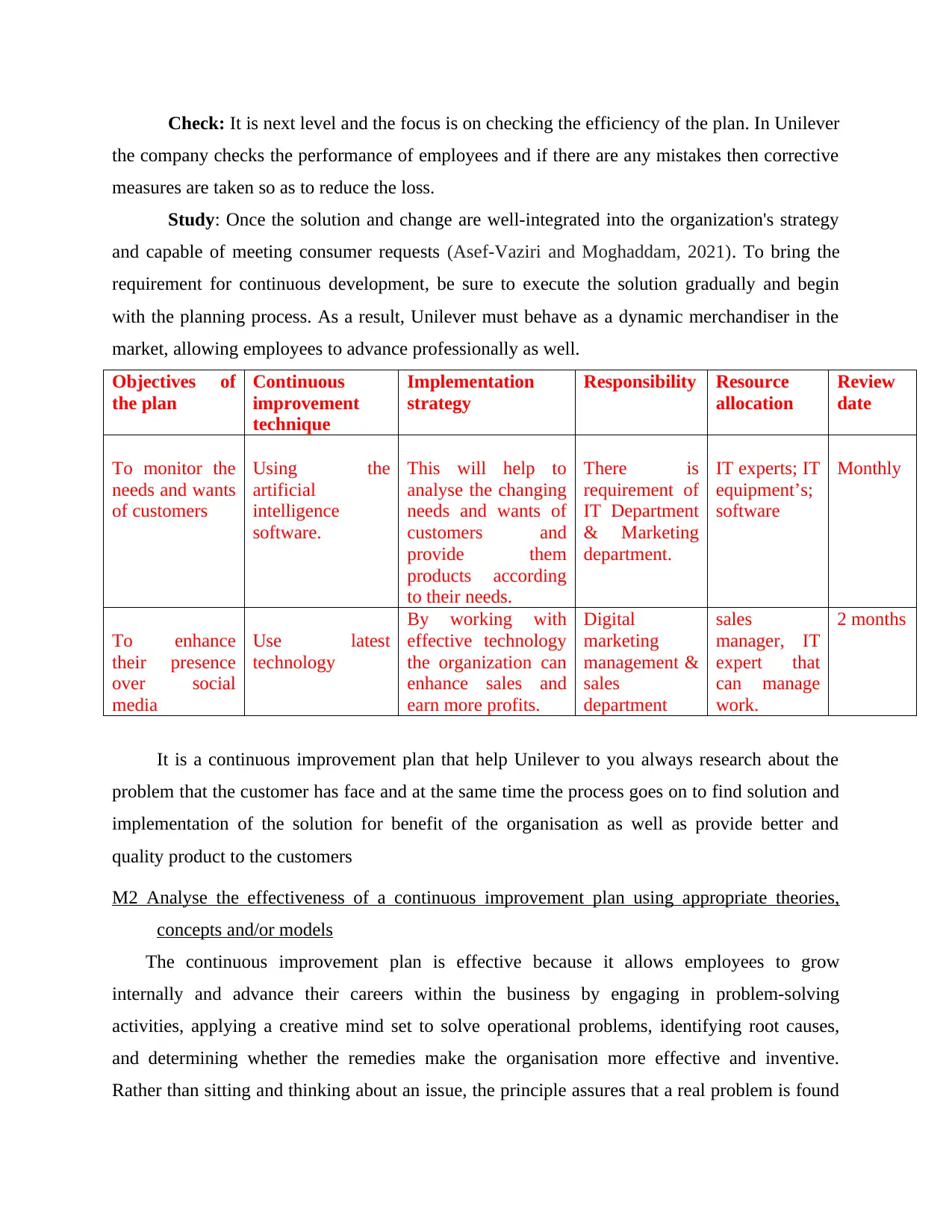
Check: It is next level and the focus is on checking the efficiency of the plan. In Unilever
the company checks the performance of employees and if there are any mistakes then corrective
measures are taken so as to reduce the loss.
Study: Once the solution and change are well-integrated into the organization's strategy
and capable of meeting consumer requests (Asef-Vaziri and Moghaddam, 2021). To bring the
requirement for continuous development, be sure to execute the solution gradually and begin
with the planning process. As a result, Unilever must behave as a dynamic merchandiser in the
market, allowing employees to advance professionally as well.
Objectives of
the plan
Continuous
improvement
technique
Implementation
strategy
Responsibility Resource
allocation
Review
date
To monitor the
needs and wants
of customers
Using the
artificial
intelligence
software.
This will help to
analyse the changing
needs and wants of
customers and
provide them
products according
to their needs.
There is
requirement of
IT Department
& Marketing
department.
IT experts; IT
equipment’s;
software
Monthly
To enhance
their presence
over social
media
Use latest
technology
By working with
effective technology
the organization can
enhance sales and
earn more profits.
Digital
marketing
management &
sales
department
sales
manager, IT
expert that
can manage
work.
2 months
It is a continuous improvement plan that help Unilever to you always research about the
problem that the customer has face and at the same time the process goes on to find solution and
implementation of the solution for benefit of the organisation as well as provide better and
quality product to the customers
M2 Analyse the effectiveness of a continuous improvement plan using appropriate theories,
concepts and/or models
The continuous improvement plan is effective because it allows employees to grow
internally and advance their careers within the business by engaging in problem-solving
activities, applying a creative mind set to solve operational problems, identifying root causes,
and determining whether the remedies make the organisation more effective and inventive.
Rather than sitting and thinking about an issue, the principle assures that a real problem is found
the company checks the performance of employees and if there are any mistakes then corrective
measures are taken so as to reduce the loss.
Study: Once the solution and change are well-integrated into the organization's strategy
and capable of meeting consumer requests (Asef-Vaziri and Moghaddam, 2021). To bring the
requirement for continuous development, be sure to execute the solution gradually and begin
with the planning process. As a result, Unilever must behave as a dynamic merchandiser in the
market, allowing employees to advance professionally as well.
Objectives of
the plan
Continuous
improvement
technique
Implementation
strategy
Responsibility Resource
allocation
Review
date
To monitor the
needs and wants
of customers
Using the
artificial
intelligence
software.
This will help to
analyse the changing
needs and wants of
customers and
provide them
products according
to their needs.
There is
requirement of
IT Department
& Marketing
department.
IT experts; IT
equipment’s;
software
Monthly
To enhance
their presence
over social
media
Use latest
technology
By working with
effective technology
the organization can
enhance sales and
earn more profits.
Digital
marketing
management &
sales
department
sales
manager, IT
expert that
can manage
work.
2 months
It is a continuous improvement plan that help Unilever to you always research about the
problem that the customer has face and at the same time the process goes on to find solution and
implementation of the solution for benefit of the organisation as well as provide better and
quality product to the customers
M2 Analyse the effectiveness of a continuous improvement plan using appropriate theories,
concepts and/or models
The continuous improvement plan is effective because it allows employees to grow
internally and advance their careers within the business by engaging in problem-solving
activities, applying a creative mind set to solve operational problems, identifying root causes,
and determining whether the remedies make the organisation more effective and inventive.
Rather than sitting and thinking about an issue, the principle assures that a real problem is found
Paraphrase This Document
Need a fresh take? Get an instant paraphrase of this document with our AI Paraphraser
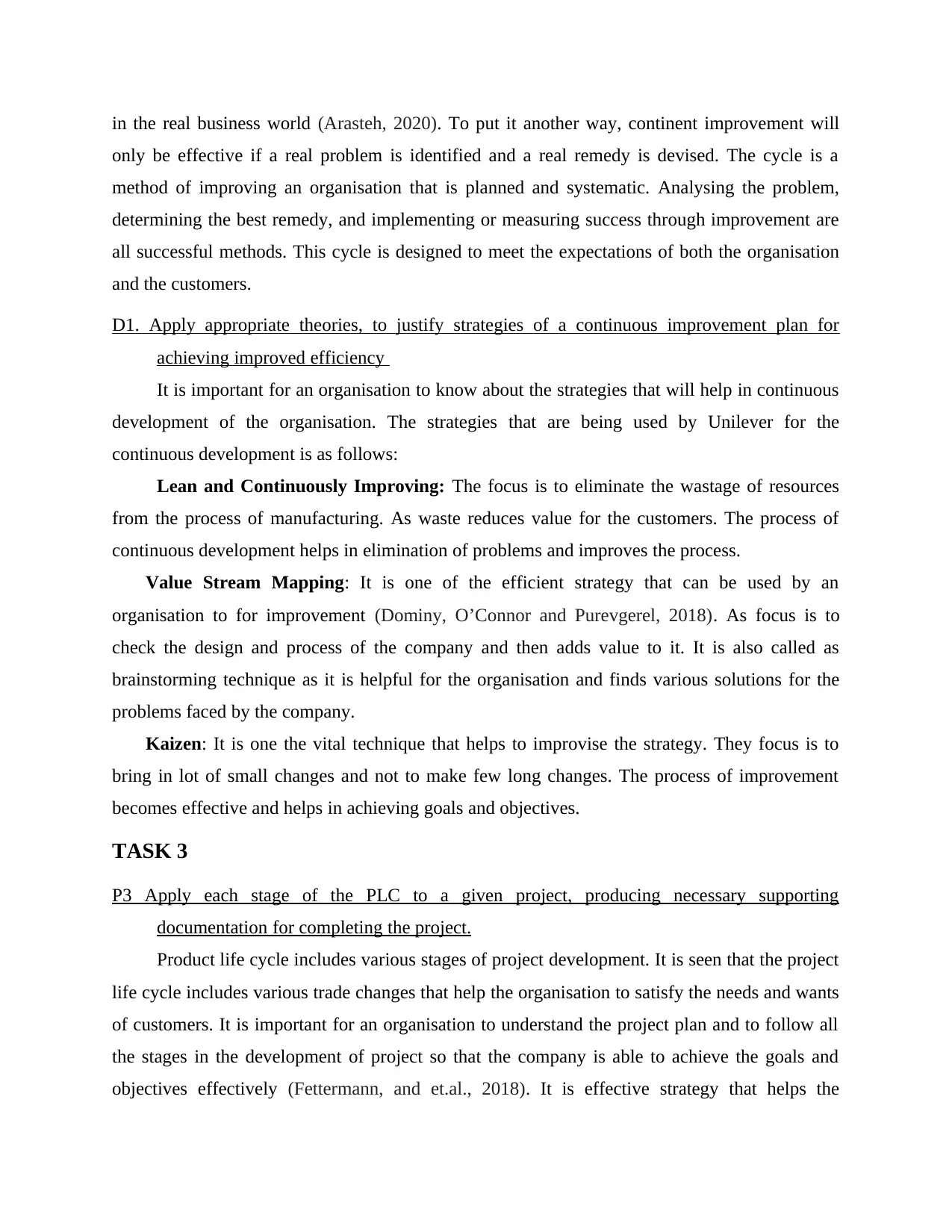
in the real business world (Arasteh, 2020). To put it another way, continent improvement will
only be effective if a real problem is identified and a real remedy is devised. The cycle is a
method of improving an organisation that is planned and systematic. Analysing the problem,
determining the best remedy, and implementing or measuring success through improvement are
all successful methods. This cycle is designed to meet the expectations of both the organisation
and the customers.
D1. Apply appropriate theories, to justify strategies of a continuous improvement plan for
achieving improved efficiency
It is important for an organisation to know about the strategies that will help in continuous
development of the organisation. The strategies that are being used by Unilever for the
continuous development is as follows:
Lean and Continuously Improving: The focus is to eliminate the wastage of resources
from the process of manufacturing. As waste reduces value for the customers. The process of
continuous development helps in elimination of problems and improves the process.
Value Stream Mapping: It is one of the efficient strategy that can be used by an
organisation to for improvement (Dominy, O’Connor and Purevgerel, 2018). As focus is to
check the design and process of the company and then adds value to it. It is also called as
brainstorming technique as it is helpful for the organisation and finds various solutions for the
problems faced by the company.
Kaizen: It is one the vital technique that helps to improvise the strategy. They focus is to
bring in lot of small changes and not to make few long changes. The process of improvement
becomes effective and helps in achieving goals and objectives.
TASK 3
P3 Apply each stage of the PLC to a given project, producing necessary supporting
documentation for completing the project.
Product life cycle includes various stages of project development. It is seen that the project
life cycle includes various trade changes that help the organisation to satisfy the needs and wants
of customers. It is important for an organisation to understand the project plan and to follow all
the stages in the development of project so that the company is able to achieve the goals and
objectives effectively (Fettermann, and et.al., 2018). It is effective strategy that helps the
only be effective if a real problem is identified and a real remedy is devised. The cycle is a
method of improving an organisation that is planned and systematic. Analysing the problem,
determining the best remedy, and implementing or measuring success through improvement are
all successful methods. This cycle is designed to meet the expectations of both the organisation
and the customers.
D1. Apply appropriate theories, to justify strategies of a continuous improvement plan for
achieving improved efficiency
It is important for an organisation to know about the strategies that will help in continuous
development of the organisation. The strategies that are being used by Unilever for the
continuous development is as follows:
Lean and Continuously Improving: The focus is to eliminate the wastage of resources
from the process of manufacturing. As waste reduces value for the customers. The process of
continuous development helps in elimination of problems and improves the process.
Value Stream Mapping: It is one of the efficient strategy that can be used by an
organisation to for improvement (Dominy, O’Connor and Purevgerel, 2018). As focus is to
check the design and process of the company and then adds value to it. It is also called as
brainstorming technique as it is helpful for the organisation and finds various solutions for the
problems faced by the company.
Kaizen: It is one the vital technique that helps to improvise the strategy. They focus is to
bring in lot of small changes and not to make few long changes. The process of improvement
becomes effective and helps in achieving goals and objectives.
TASK 3
P3 Apply each stage of the PLC to a given project, producing necessary supporting
documentation for completing the project.
Product life cycle includes various stages of project development. It is seen that the project
life cycle includes various trade changes that help the organisation to satisfy the needs and wants
of customers. It is important for an organisation to understand the project plan and to follow all
the stages in the development of project so that the company is able to achieve the goals and
objectives effectively (Fettermann, and et.al., 2018). It is effective strategy that helps the
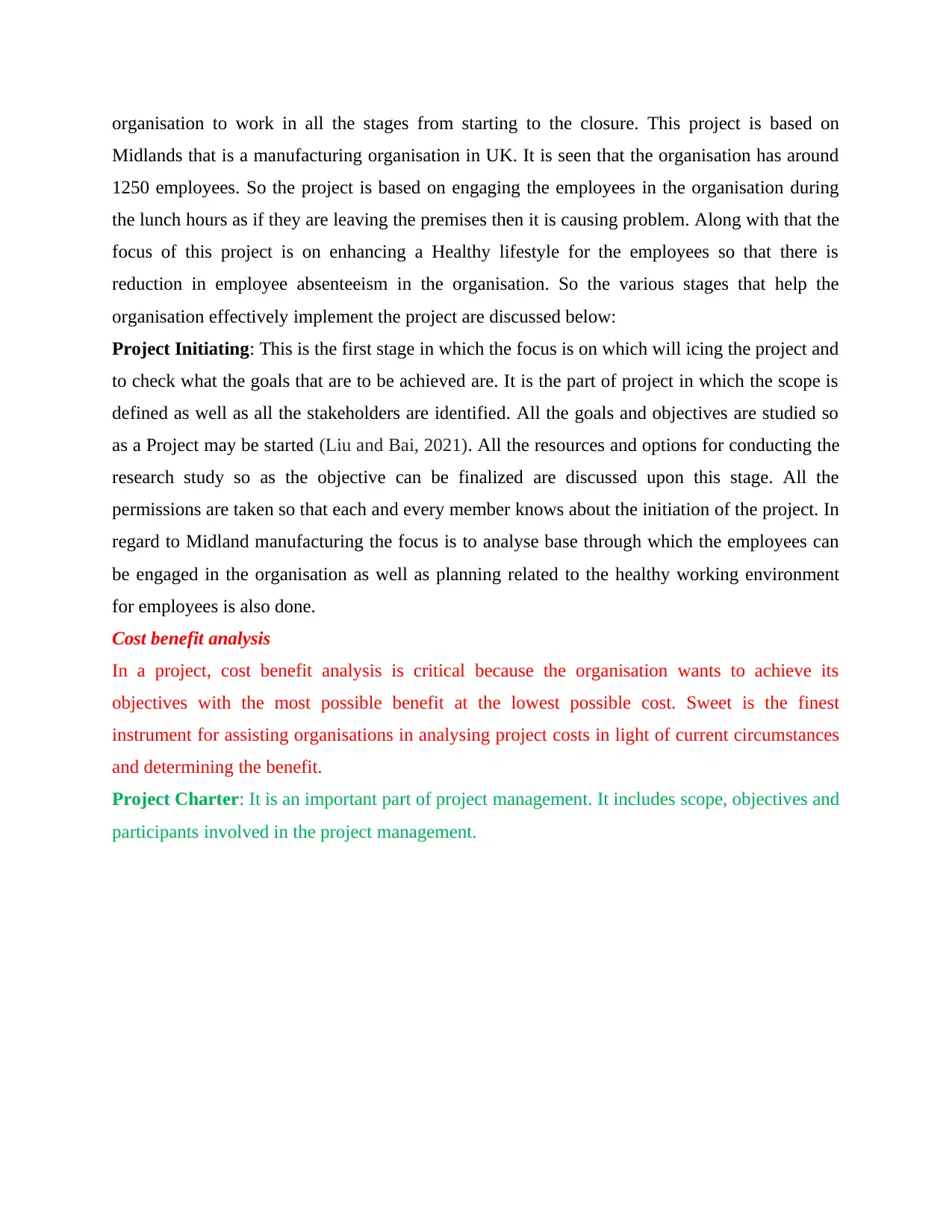
organisation to work in all the stages from starting to the closure. This project is based on
Midlands that is a manufacturing organisation in UK. It is seen that the organisation has around
1250 employees. So the project is based on engaging the employees in the organisation during
the lunch hours as if they are leaving the premises then it is causing problem. Along with that the
focus of this project is on enhancing a Healthy lifestyle for the employees so that there is
reduction in employee absenteeism in the organisation. So the various stages that help the
organisation effectively implement the project are discussed below:
Project Initiating: This is the first stage in which the focus is on which will icing the project and
to check what the goals that are to be achieved are. It is the part of project in which the scope is
defined as well as all the stakeholders are identified. All the goals and objectives are studied so
as a Project may be started (Liu and Bai, 2021). All the resources and options for conducting the
research study so as the objective can be finalized are discussed upon this stage. All the
permissions are taken so that each and every member knows about the initiation of the project. In
regard to Midland manufacturing the focus is to analyse base through which the employees can
be engaged in the organisation as well as planning related to the healthy working environment
for employees is also done.
Cost benefit analysis
In a project, cost benefit analysis is critical because the organisation wants to achieve its
objectives with the most possible benefit at the lowest possible cost. Sweet is the finest
instrument for assisting organisations in analysing project costs in light of current circumstances
and determining the benefit.
Project Charter: It is an important part of project management. It includes scope, objectives and
participants involved in the project management.
Midlands that is a manufacturing organisation in UK. It is seen that the organisation has around
1250 employees. So the project is based on engaging the employees in the organisation during
the lunch hours as if they are leaving the premises then it is causing problem. Along with that the
focus of this project is on enhancing a Healthy lifestyle for the employees so that there is
reduction in employee absenteeism in the organisation. So the various stages that help the
organisation effectively implement the project are discussed below:
Project Initiating: This is the first stage in which the focus is on which will icing the project and
to check what the goals that are to be achieved are. It is the part of project in which the scope is
defined as well as all the stakeholders are identified. All the goals and objectives are studied so
as a Project may be started (Liu and Bai, 2021). All the resources and options for conducting the
research study so as the objective can be finalized are discussed upon this stage. All the
permissions are taken so that each and every member knows about the initiation of the project. In
regard to Midland manufacturing the focus is to analyse base through which the employees can
be engaged in the organisation as well as planning related to the healthy working environment
for employees is also done.
Cost benefit analysis
In a project, cost benefit analysis is critical because the organisation wants to achieve its
objectives with the most possible benefit at the lowest possible cost. Sweet is the finest
instrument for assisting organisations in analysing project costs in light of current circumstances
and determining the benefit.
Project Charter: It is an important part of project management. It includes scope, objectives and
participants involved in the project management.
⊘ This is a preview!⊘
Do you want full access?
Subscribe today to unlock all pages.

Trusted by 1+ million students worldwide
1 out of 20
Related Documents
Your All-in-One AI-Powered Toolkit for Academic Success.
+13062052269
info@desklib.com
Available 24*7 on WhatsApp / Email
![[object Object]](/_next/static/media/star-bottom.7253800d.svg)
Unlock your academic potential
Copyright © 2020–2025 A2Z Services. All Rights Reserved. Developed and managed by ZUCOL.




